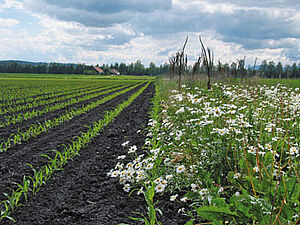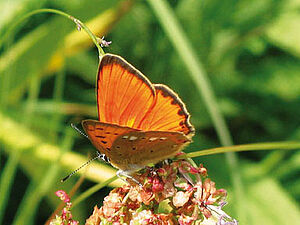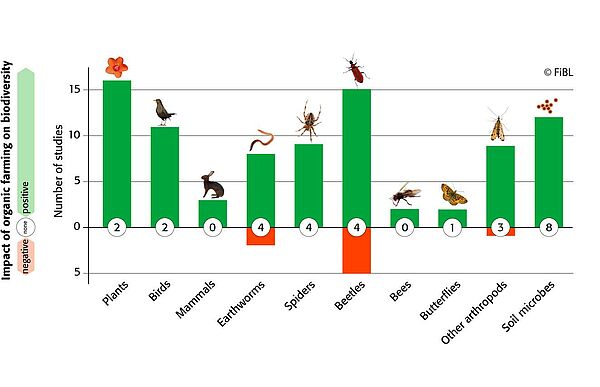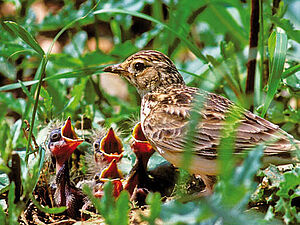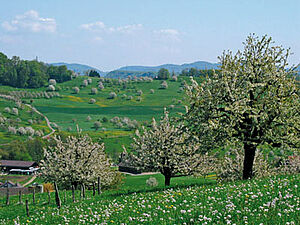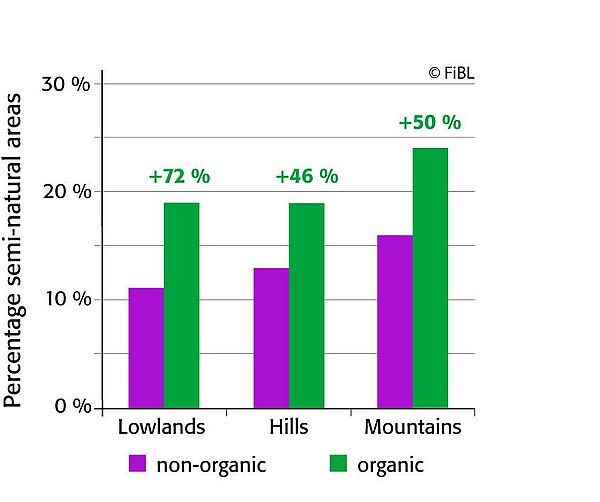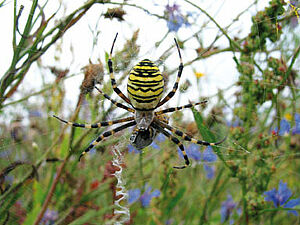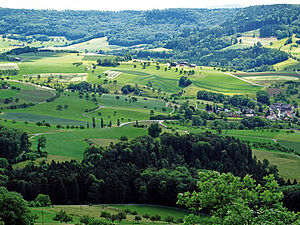Organic farming demonstrates clear advantages for biodiversity over conventional farming. Depending on altitude, organic farms have between 46 and 72 percent more semi-natural habitats and host 30 percent more species and 50 percent more individuals than non-organic farms. The lower farming intensities and higher proportion of semi-natural areas enable site-typical plant and animal species to exist on organic farms and allow farmers to benefit from an intact and therefore sustainably functioning ecosystem.
Agriculture creates biodiversity
Biodiversity encompasses diversity of life on all levels: diversity of species, genetic diversity as well as diversity of habitats and ecosystems. A rich biological diversity is essential for preserving natural processes contributing to man’s ability to live. For instance, natural pest regulation, pollination of fruit blossoms by insects, and the decomposition of organic matter into humus.
Agricultural policies are increasingly promoting ecologically-oriented farming methods that preserve biodiversity and conserve natural resources (FAO, 2002). In historical times, a more diverse landscape unfolded through farming from what was once an undifferentiated landscape dominated by forests. Today as well, a farming system that is site-adapted and using extensive forms of cultivation are essential prerequisites for a diverse, species rich landscape.
Intensive farming as one of the main causes of species decline
Decades of continuous land-use intensification have played a significant role in causing biodiversity to radically change. An enormous decline in biodiversity has been the result of intensive farming, introduction of foreign species, habitat change and fragmentation as well as scrub encroachment in mountainous regions. In addition, climate change is also increasingly causing changes in indigenous flora and fauna.
The endangered species Red Lists maintain that intensive farming is one of the main causes for species decline in cultivated landscapes (Bengtsson, J. et al. 2005, Hole, D.G. et al. 2005). Pesticide use, synthetic nitrogen fertilizer, land consolidation, drainage and the use of heavy machinery, have all contributed to a drastic loss of biodiversity.
Biodiversity: More plant and animal species on organic farms
Numerous comparative studies showing the impact of conventional and organic farming systems verify the positive effect organic farming has on flora and fauna on field and also farm level (Fuller, R.J. et al. 2005, Hole, D.G. et al. 2005). A comprehensive analysis of 66 scientific studies shows that organically farmed areas have on average 30 percent more species and 50 percent more individuals than non-organic areas (Bengtsson, J. et al. 2005). The positive effect of organic farming is most significant in cleared landscapes, but is also seen in structurally rich regions (Gabriel, D. et al. 2006, Gabriel, D. et al. 2010).
In particular birds, predatory insects, spiders, soil dwelling organisms and field flora benefit most from organic management (Figure 1). Pests and indifferent organisms on the other hand occur in similar numbers in the various farming systems. The differences in species diversity are especially noticeable
with arable and horticulture crops in valleys – the differences seen in grassland are less pronounced. Comparison studies in mountainous regions are scarcely existing.
Figure 1: Number of studies that show organic farming having a positive (green bar), negative (red bar) or no effect (number in white circle) on biodiversity of various animal and plant groups in comparison to non-organic farm management. Summary of 95 scientific publications.
Rare and endangered species on organic land
To preserve rare and endangered species, adapted species protection programmes are frequently necessary. The typical ecological compensation programmes for farmland are not sufficient. Organic farming in combination with valuable semi-natural areas can therefore significantly contribute to improving species numbers (Pfiffner, L. et al. 2003). Sky larks, a typical species that have been suppressed through intensification of farming, as well as the now rare lapwings, partridges, and whinchats, achieve higher population densities on organically managed farms (NABU 2004, Neumann, H. et al. 2007). Rare plant species on agricultural land (Gabriel, D. et al. 2006, Gabriel, D. et al. 2007) and ground beetles (Pfiffner, L. et al. 2003) are also proven to be in higher diversity and density on organic farms.
Habitat diversity: More semi-natural areas on organic farms
Next to farming intensity, the proportion of seminatural areas on the farm is a central factor for preserving biodiversity. Hedges, species and structurally rich meadows, and scrub, serve as habitat and as a temporary retreat vital for many animal species.
Comparisons in Switzerland (Schader, C. et al. 2008) and England (Gibson, R. H. et al. 2007) show, that the proportion of semi-natural areas on organic farms is higher than on conventional farms. An analysis of all Swiss farms showed that on average organic farms have 22 percent semi-natural areas and conventional farms 13 percent. Organic farms therefore implement 2/3 more measures than their conventional counterparts (Figure 2). The largest differences were seen with extensive and less intensively used meadows as well as hedges, and standard fruit trees in lowlands and hilly regions (Schader, C. et al. 2008).
Figure 2: Higher percentage of semi-natural agricultural areas (ecological compensation areas) on organic farms in various elevation zones of Switzerland in comparison to non-organic farms[19].
Higher biodiversity benefits farmers
Biodiversity is an important basis for many processes in our ecosystems to function. Habitats with numerous species are shown to better adapt to environmental changes. For instance, species rich mountain meadows erode less and allow for more stable yields during dry periods.
Critical ecological processes are influenced by the higher biodiversity and larger population densities of various species seen on organic farms. Organic farming shows significant improvements for functions such as:
- Pollination (Gabriel, D. et al. 2007, Holzschuh, A. et al. 2007, Holzschuh, A., et al. 2008, Moradin, L.A. et al. 2005)
- Reduction in soil erosion on arable land (Siegrist, S. et al. 1998)
- Decomposition of dung in pastures (Hutton, S.A. et al. 2003)
- Natural pest reduction in soil (Klingen, I. et al. 2002) and crops (Crowder, D.W. et al. 2010, Zehnder, G. et al. 2007)
Flower-visiting insects such as honeybees, wild bees, and bumblebees benefit from the higher coverage and diversity of secondary flora in organic grain fields. Biodiversity is 3 times higher and the number of bees 7 times higher than in conventional areas (Holzschuh, A. et al. 2007). With organic farming areas increasing, populations of wild bees, honeybees, and bumblebees are also markedly climbing in the surrounding farmland and semi-natural areas (Holzschuh, A. et al. 2008). Organic agriculture thus improves the pollination of flowering plants in the surrounding environment (Gabriel, D. et al. 2007).
The higher diversity of flora and fauna also encourages beneficial organisms that naturally reduce pests (Zehnder, G. et al. 2007). Organic farming leads to a significantly more balanced number of beneficial insects that reduce pests and yield losses in potato crops (Crowder, D.W. et al. 2010). Organic pastures allow richer fauna to exist in dung than conventional pastures as they are not contaminated by chemical veterinary drugs (Holzschuh, A. et al. 2007). Dung fauna considerably adds to the degradation and recycling of dung and in turn makes for better feed quality.
A more diverse flora and fauna in organic soil result in a revitalized, more active soil life (Mäder, P. et al. 2002). Research from Norway shows a stronger reduction in soil pests in organic soils than in conventional soils due to richer fungal fauna (Klingen, I. et al. 2002).
Main causes of higher biodiversity
Various farm practices and landscaping measures are implemented in organic farming that have a proven positive influence on biodiversity. The following
measures typically carried out on organic farms that most notably promote biodiversity are:
- Forgo use of herbicides
- Forgo use of chemically-synthesized pesticides
- Less and purer organic fertilizer
- Fewer cattle per square meter
- More diversified crop rotation with higher clovergrass percentage
- Conservation tillage
- Higher percentage of semi-natural areas
- Higher percentage of arable and ecological areas
- More diversified farm structure
These factors enhance not only biodiversity, but strengthen natural cycles and improve environmental performance that in turn increase the sustainability of organic farms (FAO, 2002, Pimentel, D. et al. 2005). To optimally promote biodiversity, cross-farm and landscaping measures need to be instituted – ideally on extensively managed habitats within landscapes (e.g., bioregions) (Gabriel, D. et al. 2010).
Literature
Bengtsson, J., Ahnström, J., Weibull, A.C., 2005. The effects of organic agriculture on biodiversity and abundance: a metaanalysis. Journal of Applied Ecology 42: 261-269.
Crowder, D.W., Northfield, T.D., Strand. M. & Snyder, W.E. Organic agriculture promotes evenness and natural pest control. Nature 2010, 46:109-112.
FAO, 2002. Organic agriculture, environment and food security. Environ. Nat. Res. No. 4. FAO Rom.
Fuller, R.J., Norton, L.R., Feber, R.E., Johnson, P.J., Chamberlain, D.E., Joys, A.C., Mathews, F., Stuart, R.C., Townsend, M.C., Manley, W.J., Wolfe, M.S., Macdonald, D.W. Firbank, L.G., 2005. Benefits of organic farming to biodiversity vary among taxa. Biology Letters 1: 431-434.
Gabriel, D., Roschewitz, I., Tscharntke, T., Thies, C., 2006. Beta diversity at different spatial scales: plant communities in organic and conventional agriculture. Ecological Applications 16: 2011-2021.
Gabriel, D., Tscharntke, T., 2007. Insect pollinated plants benefit from organic farming. Agriculture, Ecosystems and Environment 118: 43-48.
Gabriel, D., S. M. Sait, et al. (2010). Scale matters: the impact of organic farming on biodiversity at different spatial scales. Ecology Letters 13(7): 858-869.
Gibson, R. H., Pearce, S., Morris, R. J., Symondson, W. O. C. and Memmott, J. 2007. Plant diversity and land use under organic and conventional agriculture: a whole-farm approach. Journal of Applied Ecology 44: 792-803.
Hole, D.G., Perkins, A.J., Wilson, J.D., Alexander, I.H., Grice, P.V., Evans, A.D., 2005. Does organic farming benefit biodiversity? Biological Conservation 122: 113-130.
Holzschuh, A., Stefan-Dewenter, I., Kleijn, D., Tscharntke, T. 2007. Diversity of flower-visiting bees in cereal fields: effects of farming system, landscape composition and regional context. Journal of Applied Ecology 44: 41-49.
Holzschuh, A., Stefan-Dewenter, I. and Tscharntke, T. 2008. Agricultural landscapes with organic crops support higher pollinator diversity. Oikos 117: 354-361.
Hutton, S.A., Giller, P.S., 2003. The effects of the intensification of agriculture on northern temperate dung beetle communities. Journal of Applied Ecology 40: 994-1007.
Klingen, I., Eilenberg, J., Meadow, R., 2002. Effects of farming system, field margins and bait insect on the occurrence of insect pathogenic fungi in soils. Agriculture, Ecosystems and Environment 91: 191-198.
Mäder, P., Fließbach, A., Dubois, D., Gunst, L., Fried, P. und Niggli, U., 2002. Soil fertility and biodiversity in organic farming. Science 296: 1694-1697.
Moradin, L.A., Winston, M.L., 2005. Wild bee abundance and seed production in conventional, organic, and genetically modified canola. Ecological Applications 15: 871-881.
NABU 2004. Vögel der Agrarlandschaft – Bestand, Gefährdung, Schutz. Naturschutzbund Deutschland e.V., Berlin, p 44.
Neumann, H., Loges, R., Taube, F., 2007. Fördert der ökologische Landbau die Vielfalt und Häufigkeit von Brutvögeln auf Ackerflächen? Berichte über Landwirtschaft 85, 272-299.
Pfiffner, L., Luka, H., 2003. Effects of low-input farming systems on carabids and epigeal spiders – a paired farm approach. Basic and Applied Ecology 4: 117-127.
Pimentel, D., Hepperly, P., Hanson, J., Douds, D., Seidel, R. 2005.
Environmental, energetic, and economic comparisons of organic and conventional farming systems. Bioscience, 55(7): 573-582.
Schader, C., Pfiffner, L., Schlatter, C., Stolze, M., 2008. Umsetzung von Ökomassnahmen auf Bio- und ÖLN-Betrieben. Agrarforschung 15: 506-511.
Siegrist, S., Schaub, D., Pfiffner, L., Mäder, P., 1998. Does organic agriculture reduce soil erodibility? The results of a longterm field study on loess in Switzerland. Agriculture, Ecosystems and Environment 69: 253-265.
Zehnder, G., Gurr, G.M., Kühne, S., Wade, M.R., Wratten, S.D., Wyss, E. 2007. Arthropod pest management in organic crops. Annual Review of Entomology, 52: 57-80.





